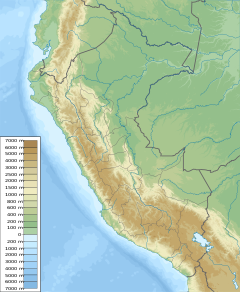Yanachaga Chemillén National Park
| Yanachaga Chemillén National Park | ||
|---|---|---|
| The pampas in the park. | ||
|
|
||
| Location: | Pasco , Peru | |
| Surface: | 1220 km² | |
| Founding: | August 29, 1986 | |
| Yanachaga Chemillén National Park (red) | ||
The Yanachaga Chemillén National Park (Spanish: Parque nacional Yanachaga Chemillén ) is a national park founded on August 29, 1986 by decree Nº 068-86-AG in the districts of Oxapampa , Villa Rica , Huancabamba and Pozuzo in the Oxapampa province in the Pasco region in Peru .
location
The park is located in the jungle of central Peru and extends over the Cordillera Yanachaga , which belongs to the eastern part of the Andes. The landscape is dominated by mountain forests with deep gorges. Overall, the terrain is very impassable with rocky, mostly steep, wooded slopes and runs east and west of the Río Pozuzo . The height differences in the park vary between 460 and 3643 meters above sea level .
The geographical features with their varied climates lead to a high diversity of ecological formations in a relatively small area. As a result of these circumstances, there is an enormous biodiversity here. In addition, the Pleistocene was a retreat for tropical vegetation, i. H. it is a haven for forest relics due to its geographical isolation and this at a time when the Amazon forests are being replaced by grasslands as a consequence of climate change. These Pleistocene refuges also explain the enormous biodiversity in this area.
From a cultural point of view, the area can be seen as a buffer zone between three population groups. On the one hand there is the ethnic indigenous group of the Yanesha who live on the eastern flank of the Cordillera Yanachaga in the so-called Palcazú basin . On the other hand, there are settlers of European origin, mainly Germans and Austrians, as well as immigrants from the central highlands of Peru who live on the eastern flank of the mountains in the valley of Oxapampa-Pozuzo.
fauna
The biological diversity is enormous with numerous species.
Mammals
In the park u. a. Gardner's shrew rat ( Monodelphis gardneri ), the capybara ( Hydrochoerus hydrochaeris ), the jaguar ( Panthera onca ), the puma ( Puma concolor ), the brown woolly monkey ( Lagothrix lagotricha ), the pakas ( Cuniculus paca ), the spectacled bear ( Tremarctos ornatus ) the Northern Pudu ( Pudu mephistophiles ), the Ozelot ( leopardus pardalis ), the Jaguarundi ( Puma yagouaroundi ), the white-tailed deer ( Odocoileus virginianus ), the culpeo ( Lycalopex culpaeus ) and the Andean Skunk ( Conepatus chinga ) before.
Birds
527 species of birds also live in the park. To live here warded bird ( Eubucco versicolor ), Kapuzentinamu ( Nothocercus nigrocapillus ), black-winged parrot ( Hapalopsittaca melanotis ), cloud forest Screech Owl ( Megascops marshalli ) Grünweißamazilie ( Amazilia viridicauda ) Hartertkolibri ( Phlogophilus harterti ), Redwing Brillant Hummingbird ( Heliodoxa branickii ), blue-banded toucanet ( Aulacorhynchus coeruleicinctis ) Gray-breasted mountain toucan ( Andigena hypoglauca ) Orbignyzwergspecht ( Picumnus dorbignyanus ) Blaukappenpipra ( Lepidothrix coeruleocapilla ) Schmuckbauchkotinga ( Pipreola intermedia ), Gelbbrustkotinga ( Pipreola pulchra ), yellow streak-free bully ( Zimmerius viridiflavus ), gray face Laubtyrann ( Leptopogon taczanowskii ) , ocher neck Schnäppertyrann ( Nephelomyias ochraceiventris ), gray cap Todityrann ( Hemitriccus rufigularis ), white-bellied dwarf bully ( Myiornis albiventris ) Olivbauch-Schnäppertyrann ( Mitrephanes olivaceus ), rust binding-Busch bully ( Myiotheretes fuscorufus ), yellow brow Schmätzertyrann ( Si lvicultrix pulchella ), Light gray Tapaculo ( Scytalopus unicolor ), rust colored Ameisenpitta ( Grallaria Capitalis ), Brown back tree Scout ( Thripadectes scrutator ) Blaukehlhäher ( Cyanolyca viridicyanus ), Peru Wren ( Cinnycerthia peruana ) Weißohrklarino ( Entomodestes leucotis ), Greenie end Vogel ( Psarocolius atrovirens ), Plain hemispingis ( Pseudospingus xanthophthalmus ), brown-bellied mountain tangar ( Dubusia castaneoventris ), golden ribbon tangar ( Iridosornis reinhardti ). There are also golden-throated toucans ( Ramphastos ambiguus ) and the Peruvian national bird , the Andean cliff bird ( Rupicola peruviana ).
Reptiles
Among the reptiles in the park you can find a. the crocodile caiman ( Caiman crocodilus ) and the brow-smooth-forehead caiman ( Paleosuchus palpebrosus ). In 2012, Edgar Lehr , Jiří Moravec and Juan Carlos Cusi described two new frog species Phrynopus curator and Phrynopus badius from the area for science.
flora
In 2010 Sandra Knapp described the new species Solanum oxapampense , which is also present in the park.
climate
The average annual precipitation is 1500 mm on the Oxapampa flank and up to 6000 mm on the Palcazú flank. Inside the park, the valleys of Río Pozuzo, Río Palcazú and Río Pichis have a hot and humid climate with average temperatures of 23 to 26 ° C. In the city of Oxapampa , the Cordillera Yanachaga, the San Matías-San Carlos forest reserve and the districts of Villa Rica, Huancabamba and Chontabamba there is a moderate to humid climate with temperatures between 13 and 20 ° C.
literature
- Edgar Lehr, Jiří Moravec, Juan Carlos Cusi: Two new species of Phrynopus (Anura, Strabomantidae) from high elevations in the Yanachaga-Chemillén National park in Peru (Departamento de Pasco) . In: ZooKeys . tape 235 , 2012, p. 51-71 , doi : 10.3897 / zookeys.235.3885 .
- Sandra Knapp: New species of Solanum (Solanaceae) from Peru and Ecuador . In: PhytoKeys . No. 1 , 2010, ISSN 1314-2003 , p. 42-45 , doi : 10.3897 / phytokeys.1.659 .
Individual evidence
- ↑ DECRETO SUPREMO Nº 068-86-AG - Parque Nacional Yanachaga Chemilén (Spanish)
- ↑ a b c d e f g Yanachaga Chemillén near Sernap
- ↑ BirdLife Important Bird and Biodiversity Areas - Yanachaga Chemillen (Cordillera Yanachaga IBA)
- ↑ Edgar Lehr u. a., pp. 51-71.
- ↑ Sandra Knapp, pp. 42–45.


